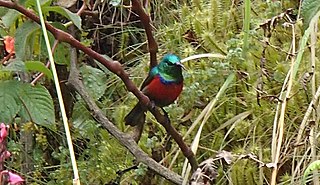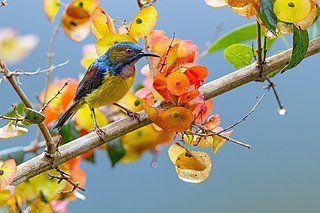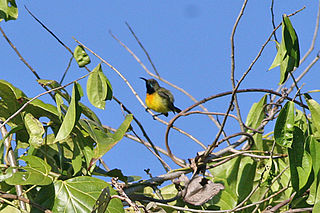
The beautiful sunbird, formerly placed in the genus Nectarinia, is a small passerine bird in the sunbird family Nectariniidae. It is native to tropical Africa, its range extending from Senegal and Guinea in the west to Sudan, South Sudan, Ethiopia, Tanzania and Kenya in the east. It was formerly considered to be conspecific with the gorgeous sunbird.

The garden sunbird, previously known as the olive-backed sunbird, is a species of passerine bird in the family Nectariniidae that is found in the Philippines except on the Palawan island group. It was formerly considered to be conspecific with seven other species: the ornate sunbird, Palawan sunbird, Sahul sunbird, Tukangbesi sunbird, Flores Sea sunbird, South Moluccan sunbird and the Mamberamo sunbird. It is a small, brightly coloured bird with olive-green plumage on the wings and back with a bright yellow chest. It has a long downward-curved bill it uses for taking nectar and capturing insects. It is primarily nectarivorous, but will take insects and spiders, particularly when feeding chicks.

The Rwenzori double-collared sunbird, also called Stuhlmann's sunbird or the Rwanda double-collared sunbird, is a species of bird in the family Nectariniidae. It is found in the Ruwenzori range of mountains in south central Africa. Its natural habitat is subtropical or tropical dry forests. It is threatened by habitat loss. It is sometimes considered to be a subspecies of the greater double-collared sunbird. Some authors consider this bird to be part of a species complex with Cinnyris afer, where it joins Ludwig's double-collared sunbird and Prigogine's double-collared sunbird. As with other closely related species, each inhabiting different locations, there are subtle similarities and differences between the local populations, and their taxonomic treatment depends on the views of the taxonomist.
Prigogine's sunbird or Prigogine's double-collared sunbird is a species of bird in the family Nectariniidae.

The Sunda brush cuckoo is a species of cuckoo in the family Cuculidae. It is found in Indonesia, Malaysia, the Philippines, Singapore, and Thailand. Its natural habitat is subtropical or tropical moist lowland forests. It was formerly treated as conspecific with the Sulawesi brush cuckoo with the English name "rusty-breasted cuckoo".

The brown-throated sunbird, also known as the plain-throated sunbird, is a species of bird in the family Nectariniidae. It is found in a wide range of semi-open habitats in south-east Asia, ranging from Myanmar to the Lesser Sundas and west Philippines. The grey-throated sunbird found in the remaining part of the Philippines is often considered a subspecies of the brown-throated sunbird, but the two differ consistently in measurements and plumage, and there is no evidence of intergradation between them.

The black sunbird is a species of bird in the family Nectariniidae. It is found in eastern Indonesia and New Guinea. Its natural habitats are subtropical or tropical moist lowland forest and subtropical or tropical mangrove forest.

The apricot-breasted sunbird is a species of bird in the family Nectariniidae. It is endemic to the island of Sumba in Indonesia, where its natural habitats are subtropical or tropical moist lowland forests and subtropical or tropical moist montane forests. Although it is quite common, very little is known about its biology, with virtually nothing known about its breeding or diet.

Humblot's sunbird is a species of bird in the family Nectariniidae. It is endemic to the islands of Grand Comoro and Mohéli in the Comoros.

The northern double-collared sunbird, is a species of bird in the family Nectariniidae. It is found in Burundi, Cameroon, Central African Republic, Democratic Republic of the Congo, Equatorial Guinea, Kenya, Nigeria, Rwanda, South Sudan, and Uganda.

The regal sunbird is a species of bird in the family Nectariniidae. It is native to the Albertine Rift montane forests.

The Sulawesi pitta is a species of pitta. It was considered a subspecies of the red-bellied pitta. It is endemic to Indonesia where it occurs in Sulawesi, Manterawu, and Togian Islands. Its natural habitat is subtropical or tropical moist lowland forest. It is threatened by habitat loss.
The Tukangbesi sunbird is a species of passerine bird in the sunbird family Nectariniidae that is found on the Tukangbesi Islands that lie to the southeast of Sulawesi in Indonesia. It was formerly considered to be a subspecies of the olive-backed sunbird, now renamed the garden sunbird.

The eastern hooded pitta is a passerine bird in the pitta family Pittidae that is endemic to New Guinea and some of the small neighbouring islands.
The supertramp fantail is a species of bird in the family Rhipiduridae that is found on the Lesser Sunda Islands, Maluku Islands, Kai Islands and Aru Islands. It was formerly considered to be subspecies of the Arafura fantail. Its natural habitat is subtropical or tropical moist lowland forests.

The ornate sunbird is a species of bird in the sunbird family Nectariniidae that is endemic to Mainland Southeast Asia, Sumatra, Java, Borneo and the Lesser Sunda Islands. It was formerly considered to be a subspecies of the olive-backed sunbird, now renamed the garden sunbird.

The south Moluccan sunbird is a species of bird in the sunbird family Nectariniidae that found on some of the Maluku Islands, between Sulawesi and New Guinea in Indonesia. It was formerly considered to be a subspecies of the olive-backed sunbird, now renamed the garden sunbird.

The Flores Sea sunbird is a species of bird in the sunbird family Nectariniidae that is found on several small islands in the Flores Sea. It was formerly considered to be a subspecies of the olive-backed sunbird, now renamed the garden sunbird.
The Mamberamo sunbird or Rand's sunbird, is a species of bird in the sunbird family Nectariniidae that is found in northern New Guinea. It was formerly considered to be a subspecies of the olive-backed sunbird, now renamed the garden sunbird.

The Palawan sunbird is a species of bird in the sunbird family Nectariniidae that is found on the islands of the Palawan group in the Philippines. It was formerly considered to be a subspecies of the olive-backed sunbird, now renamed the garden sunbird.


















